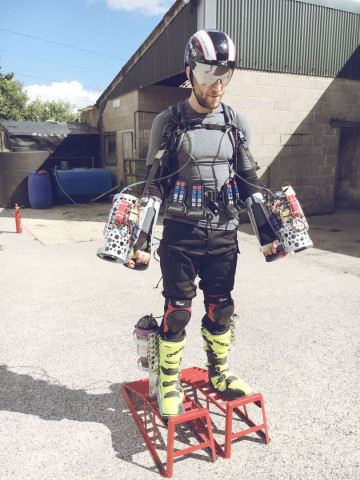Meet the real-life Iron Man
38-year-old Richard Browning has been building an exosuit powered by jet engines for the past 18 months

Richard Browning built a exoskeleton that helps him fly. Photo Courtesy: Wired UK
The 38-year-old amateur inventor has secretly been building a jet-engine powered exoskeleton suit in the garage of his Salisbury, south England home, and he recently unveiled how he can hover in air like a superhero thanks to his futuristic ensemble.
The suit consists of three sets of miniature jet engines attached at the arms and at the back. Browning experimented in his garage for 18 months, trying to figure out the optimal position and number of jet engines he could use to fly without carrying too much equipment.
Japanese firm showcases thought-controlled robotic suits
"The philosophy behind all this was: Could we reimagine how a really raw form of human flight would work?" says Browning.
"The human body is very good at being trained to do specific things, and it's a useful structure. So, we had this idea — rather than go and rely on aluminum structures to build the machine and rely on gyros and computers to achieve stability, why not rely on the human machine, keep it as raw and original as possible?"
Even though Browning is a former marine reservist who runs ultramarthons and performs calisthenics stunts, he admits that piloting uses a lot of strength. Since there is no steering mechanism in the suit, speed and direction can only be adjusted by changing the thrust of the engine, which means relying solely on upper body strength. A trigger in the right hand controls the arm engines and one on the left hand controls the engine in the back.
The Greek myth of Daedalus, who made himself wings to escape captivity, is what inspired Browning to create the suit. And he named it after Daedalus.
In first, Karachi's UIT students develop robotic legs for the disabled
For now Browning can stay airborne for up to 10 minutes in the suit around 3-6 feet from the ground, but he thinks he can eventually fly up to 330 feet and have a speed of about 100 km/h.
He plans to improve the suit's performance by adding a suspension mechanism to make manoeuvering it easier.
Lately, Browning has been flooded not only with invitations to demonstrate the technology at high-profile events but also with queries from daredevils and wealthy technology lovers keen to have their own Iron Man-style flying suits.
"The cost is about $250,000, so it's something that you could buy instead of a Lamborghini," Browning said. "It's not intended for the mass market at this stage."
This article originally appeared on Live Science.



















COMMENTS
Comments are moderated and generally will be posted if they are on-topic and not abusive.
For more information, please see our Comments FAQ